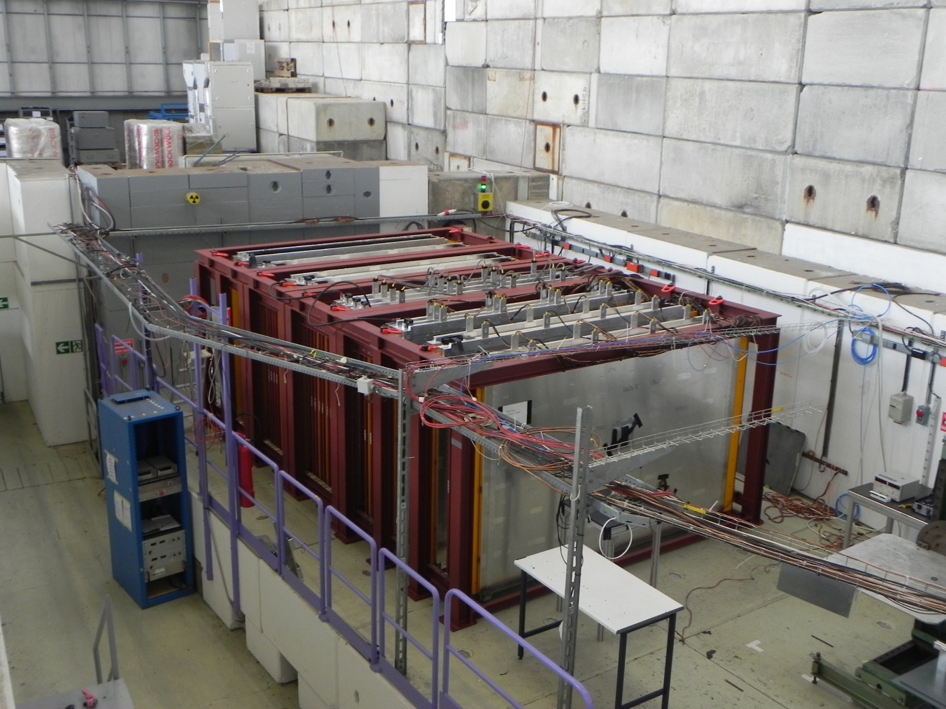Baby MIND born at CERN

Born from prototyping activities launched within the AIDA project, the Baby MIND aims to measure the momentum and identify the charge of muons that are the product of neutrino interactions in the WAGASCI detector at J-PARC. The WAGASCI detector, experiment T59, is located in the same building that houses the suite of near detectors for the T2K experiment, 280 m from the proton target and 295 km from the Super-Kamiokande detector. It is exposed to a flux of neutrinos with very similar properties to those measured by the T2K ND280 detector, though with a slightly higher mean energy due to the lower off-axis angle (1.6° vs 2.5°) with respect to the target.
T2K made the first observation of electron neutrino appearance in a muon neutrino beam in 2013 with a 7.3σ significance. In studying muon neutrino oscillations to electron or tau neutrinos on their journey from Tokai to Kamioka, it is crucial to know their interaction cross-sections and fluxes. The T59 experiment proposes to measure the ratio of cross-sections in water and plastic scintillator to contribute to reductions in target nuclei-dependent neutrino cross-section errors. The WAGASCI 3D grid-like neutrino detector has both higher water fraction and larger angular acceptance compared with the existing ND280 water/hydrocarbon sections.
Since its approval in December 2015 by the CERN Research Board, the Baby MIND collaboration - comprising CERN, the Institute for Nuclear Research of the Russian Academy of Sciences(RU), and the universities of Geneva(CH), Glasgow(UK), Kyoto University (JP), Sofia(BG), Tokyo(JP), Uppsala(SE), Valencia (ES), Yokohama(JP) - has been busily designing, prototyping, constructing and testing this muon spectrometer. It is fully integrated into the CERN Neutrino Platform, as experiment NP05, and has therefore benefited from the development environment provided by the platform.
The key elements of this detector are the magnet modules, electronics and scintillator counters, all of which were custom-developed. The design and construction of the magnet modules within EP-ADO was the responsibility of Herman Ten Kate. The magnet construction phase that lasted 6 months was completed in mid-February 2017, two weeks ahead of schedule.
The magnet design addresses stringent access constraints at J-PARC through a narrow shaft down to the floor hosting the experiment. It marks a significant departure from traditional magnetized iron neutrino detectors which have large coils threaded through the entire iron mass: each of the 33 Baby MIND iron plates (3500 ´ 2000 ´ 30 mm3, 2 tons) is magnetized by its own aluminium coil. In addition to much greater flexibility in the positioning of the iron plates with respect to each other, the power consumption is very low, 11.5 kW total, and the stray fields are negligible, maximum 15 mT on the surface of the iron plates. The field uniformity is excellent over a wide area of the magnet module.
Detector sensing elements are plastic scintillator slabs produced under the responsibility of the Institute For Nuclear Research in Moscow. Wavelength shifting fibers embedded in the plastic transmit light produced by the interactions of ionizing particles to silicon photomultipliers read out by Front End Boards developed by the University of Geneva.
The fully assembled Baby MIND detector was qualified with cosmic rays prior to tests on a beamline at the experimental zone of the Proton Synchrotron in the East Area during the summer 2017. Data are being analysed, with preliminary results showing the detector to be working as expected.
The Baby MIND will be shipped to Japan in October 2017, with installation and commissioning at J-PARC planned for the 1st and 2nd quarters of 2018 respectively.
One of the 33 magnet modules produced by EP-ADO. Each of these 2-ton modules has its own coil, assembled from strips of aluminium that are welded to neighbouring strips via interconnects at the top and bottom of the ARMCO steel plate.
The Baby MIND under test on the T9 beamline at the Proton Synchrotron experimental hall in the East Area, summer 2017.
Event displays, side view of the Baby MIND, -3 GeV/c muon on the left and +3 GeV/c muon on the right.
